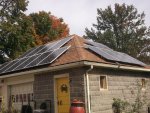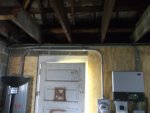As a result of the visual electrical inspection conducted at ##########. Our concerns listed in the attached document need your attention.
Feel free to contact me to discuss any of the items listed if needed.
At the premise located at ######## consist of a main building and a secondary garage. The subject of this letter is corrections needed to the PV system consisting of roof mounted solar arrays and associated equipment installed at both the main building and the secondary garage.
The following corrections are needed to obtain compliance with NFPA 70 2008. (The Fine print note included is an informational note only and is being included to provide clarification for the requirement found in 250.58
1. Identification in the form of a directory plague at both the utility supply( ?utility Service Disconnect?) and the solar supply (solar ?service disconnect?)as required by section 225.37,230.3,690.56 & 705.10
2. Bonding together the existing utility service grounding electrodes and the newly installed solar system electrodes to limit potential differences between the two associated wiring systems as indicated in the fine print note following the requirement found in 250.58
(FPN Bonding together of all separate grounding electrodes will limit potential differences between them and between their associated wiring systems.)
3. At the main building roof top array, an additional grounding electrode conductor connected directly to the array frame(s) or structure and bonded to the main buildings grounding electrode system. ( note: refer to correction item #2) 690.47 (D)
4. At the secondary garage building roof top array, an additional grounding electrode conductor connected directly to the array frame(s) or structure and bonded to the garage buildings grounding electrode system. 690.47 (D)
5. Removal of the PVC interior conduit wiring method at both the main building and the secondary garage building Direct-Current Photovoltaic Source and Output Circuits Inside a Buildings and install using metal wiring methods from the point of penetration of the surface of the building or structure to the first DC rated disconnecting means 690.31(E)
225.37 Identification.
230.2 (E) Identification
690.56 (B) Identification of Power Sources.
705.10 Directory.
250.58 Common Grounding Electrode.
690.47 (D)Additional Grounding Electrode System.
690.31 IV. Wiring Methods, Methods Permitted.
225.37 Identification. Where a building or structure has any combination of feeders, branch circuits, or services passing through it or supplying it, a permanent plaque or directory shall be installed at each feeder and branch-circuit disconnect location denoting all other services, feeders, or branch circuits supplying that building or structure or passing through that building or structure and the area served by each.
230.2 Number of Services. (E) Identification. Where a building or structure is supplied by more than one service, or any combination of branch circuits, feeders, and services, a permanent plaque or directory shall be installed at each service disconnect location denoting all other services, feeders, and branch circuits supplying that building or structure and the area served by each. See 225.37.
690.56 Identification of Power Sources. (B) Facilities with Utility Services and PV Systems. Buildings or structures with both utility service and a photovoltaic system shall have a permanent plaque or directory providing the location of the service disconnecting means and the photovoltaic system disconnecting means if not located at the same location.
705.10 Directory. A permanent plaque or directory, denoting all electric power sources on or in the premises, shall be installed at each service equipment location and at locations of all electric power production sources capable of being interconnected.
250.58 Common Grounding Electrode.
Where an ac system is connected to a grounding electrode in or at a building or structure, the same electrode shall be used to ground conductor enclosures and equipment in or on that building or structure. Where separate services, feeders, or branch circuits supply a building and are required to be connected to a grounding electrode(s), the same grounding electrode(s) shall be used.
Two or more grounding electrodes that are bonded together shall be considered as a single grounding electrode system in this sense.
690.47 Grounding Electrode System. (D) Additional Electrodes for Array Grounding.
Grounding electrodes shall be installed in accordance with 250.52 at the location of all ground- and pole-mounted photovoltaic arrays and as close as practicable to the location of roof-mounted photovoltaic arrays. The electrodes shall be connected directly to the array frame(s) or structure. The dc grounding electrode conductor shall be sized according to 250.166. Additional electrodes are not permitted to be used as a substitute for equipment bonding or equipment grounding conductor requirements.
The structure of a ground- or pole-mounted photovoltaic array shall be permitted to be considered a grounding electrode if it meets the requirements of 250.52. Roof-mounted photovoltaic arrays shall be permitted to use the metal frame of a building or structure if the requirements of 250.52(A)(2) are met.
690.31(E) Direct-Current Photovoltaic Source and Output Circuits Inside a Building. Direct-Current Photovoltaic Source and Output Circuits Inside a Building. Where direct-current photovoltaic source or output circuits of a utility-interactive inverter from a building-integrated or other photovoltaic system are run inside a building or structure, they shall be contained in metal raceways, or metal enclosures, from the point of penetration of the surface of the building or structure to the first readily accessible disconnecting means. The disconnecting means shall comply with 690.14(A) through (D).
Sincerely
Electrical Code official
David
Solar PV Contractors Response
David,
1: We will provide a placard indicating that the location of the ?pre-existing? building service is located in the basement opposite the wall where the solar disconnect is located. See attached. We can put either of these up, let me know which one. We do not agree with your assessment but as I told you on the day of inspection, we will make the change in the interest of expediting the process, you just have to tell us what you want.
? 690.56 says this is only necessary when the added solar disconnect is not located next to the meter which in this case it is. There is a single disconnect located within 10 ft and visual site of the service meter as required by the PUC. This single disconnect terminates ALL solar AC circuits with a single fused disconnect.
o 690.3 says that 690 supersedes conflicts in other parts of the code.
2, 3 & 4 are already installed and to code. Please specify what is out of code with these three points ASAP. We cannot fix what we do not know is broke. We cannot commit a crew to the field until we know exactly what we need to do at the site. As I explained and showed you on site, the panels are bonded to the rail via a WEEB, the rails are bonded to each other and the ground for the system, the entire system is bonded to new ground electrodes located at both the main house and the garage. Both new ground electrodes are tied together and tied to the existing house ground. All grounding conductors are either continuous, bonded at a grounding bar or utilize a rated bonding method.
5 We agree with this and will correct. Had you pointed this out when you first inspected we would have corrected it immediately. My crew was confused about occupancy type and thought it was acceptable in a garage. This has now been corrected in our internal processes.
Thanks,
##############




